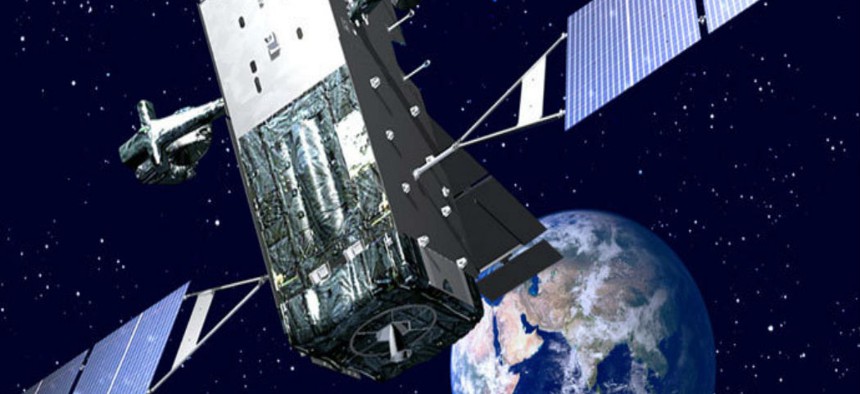Air Force launches new space war effort
Secretary of the Air Force Heather Wilson has established a new deputy chief of staff for space operations to sharpen the focus on being prepared for enemy attacks in space.
The Air Force is intensifying preparations and strategies to be ready for the prospect of war in space.
Secretary of the Air Force Heather Wilson announced the formation of a new deputy chief of staff for space operations, a three-star general officer tasked with sharpening the focus on preparing the U.S. for space attacks.
“This is the next step in our effort to integrate, normalize and elevate space operations in the Air Force,” Wilson said. “The United States is dependent upon space and our adversaries know it. We must organize and train forces to prevail in any future conflict which could extend into space.”
GPS-guided Joint Direct Attack Munitions, or JDAMs, rely upon satellite technology to hit targets, as do small, hand-held navigational force tracking systems for dismounted soldiers on the move in combat.
The Air Force Secretary has also said the service needs to acquire new space technologies more quickly to ensure U.S. dominance in space as the domain rapidly becomes more contested.
The idea, naturally, is to prepare the U.S. Space enterprise for a threatening, high-risk contested environment wherein anti-satellite (ASA) weapons proliferate around the globe.
The Air Force is investing $5.5 billion over the next five years as part of this effort.
While several countries are known to be making investments in the development of space weaponry, Chinese activities have engendered particular concern among Pentagon leaders, analysts and threat assessment professionals.
The Chinese fired a land-based kinetic energy SC-19 missile at a satellite several years ago, an action that inspired worldwide attention and condemnation. Pentagon officials say the Chinese program is very advanced.
As long ago as 2007, they launched an ASAT test of a low-altitude interceptor. They struck and destroyed a defunct Chinese weather satellite and created tens of thousands of pieces of debris, Air Force senior leaders have explained.
In response, the U.S. Joint Space Operations center issued a warning to other countries that operate satellites to stay clear of potentially damaging space debris. Since this time, the Chinese have continued to conduct live-fire tests of ASAT weapons while avoiding repeated attacks on actual satellites.
The U.S. operates Advanced Extremely High Frequency, or AEHF, communication satellites, which have replaced the older Milstar systems; they operate at 44 GHz uplink and 20 GHz downlink.
Although many of the details pertaining to U.S. space defenses and countermeasures are secret, there are some discussable elements of the Air Force effort to foster more resilient space assets. These include additional investments in remote sensing technologies and maneuverability tactics.
Disaggregation and diversity are among the most heavily emphasized countermeasure techniques, which seek to deploy multiple satellites carrying both conventional and nuclear systems; diversity tactics are aimed at using multiple satellites to achieve the same goal.
“The satellite architecture is not as vulnerable as many have maintained,” an Air Force official familiar with the plan explained.
For instance, U.S. equipment can use both GPS and Europe’s Galileo navigation system, Air Force officials said. Naturally, this method would allow U.S. forces to use allied assets if U.S. satellites were disrupted or destroyed by enemy attack.
The distribution strategy is designed to spread satellites apart, should some assets be destroyed. Deception tactics are used so that potential adversaries are not aware of which satellites perform certain functions. “There is no one node that is invulnerable to attack,” a senior Air Force official said.
Some satellites are purely used for communications, whereas others are GPS-oriented or geared toward what Air Force professionals describe as Space-Based Infrared Systems, or SBIRS, assets. SBIRS are engineered to detect the large thermal signal from an enemy intercontinental ballistic missile launch to better enable missile defense technology to intercept an approaching attack.
Proliferation and protection are also part of the strategic initiative; this involves deploying multiple satellites to perform the same mission and taking specific technical steps to harden satellites against attacks. Hardening satellites will involve developing methods of allowing them to operate in an environment where there might be electronic warfare attacks.
The service mapped out a multi-dimensional space weapons defense plan, resulting from several years of space-focused analysis and research. In 2014, the service conducted a Space Strategic Portfolio Review in which the entire space architecture was assessed.
By 2015, the Air Force had completed a “space situational awareness” review highlighting the range of key space security issues as a foundation for the changing strategy.
Overall, the Air Force and Defense Department have stepped up space development and collaboration, designed to properly respond to what experts cite as a commercial renaissance in space research, development and technological advances.
For instance, the Defense Advanced Research Projects Agency (DARPA) has formally handed over its high-tech, wide-angle view Space Surveillance Telescope, which, among other things, can detect potentially dangerous asteroids or attacks at farther distances than previous systems could, a Pentagon statement said.





